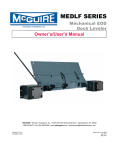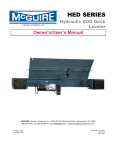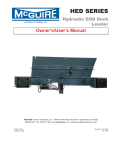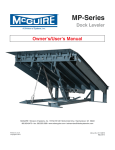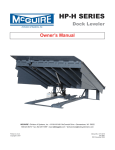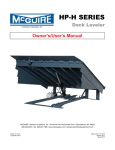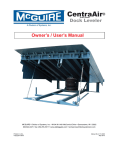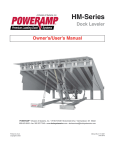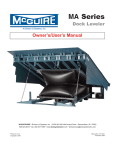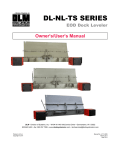Download “MEDLF” SERIES Owner/User Manual
Transcript
MEDLF SERIES Mechanical EOD Dock Leveler Owner’s/User’s Manual MCGUIRE • Division of Systems, Inc. • W194 N11481 McCormick Drive • Germantown, WI 53022 800.624.8473 • fax: 262.255.9399 • www.wbmcguire.com • [email protected] Printed in U.S.A. Copyright © 2009 Manual No. 4111-0026 Sept. 2009 Table of Contents Page Safety Recognize Safety Information . . . . . . . . . . . . . . . . . . . . . . . . . . . . . . . General Operational Safety Precautions . . . . . . . . . . . . . . . . . . . . . . Operational Safety Precautions . . . . . . . . . . . . . . . . . . . . . . . . . . . . . Maintenance Safety Precautions . . . . . . . . . . . . . . . . . . . . . . . . . . . . Safety Decals . . . . . . . . . . . . . . . . . . . . . . . . . . . . . . . . . . . . . . . . . . . . 1 1 2 4 5 Introduction General Information . . . . . . . . . . . . . . . . . . . . . . . . . . . . . . . . . . . . . . . 6 Dock Leveler Stock Specifications . . . . . . . . . . . . . . . . . . . . . . . . . . . 6 Installation Installation Details . . . . . . . . . . . . . . . . . . . . . . . . . . . . . . . . . . . . . . . . 7 Flush Mount-Weld On . . . . . . . . . . . . . . . . . . . . . . . . . . . . . . . . . . . . . 8 Ramp Mount - Weld/Bolt On . . . . . . . . . . . . . . . . . . . . . . . . . . . . . . . . 10 Flush Mount - Bolt On . . . . . . . . . . . . . . . . . . . . . . . . . . . . . . . . . . . . 12 Ramp Mount - Weld On w/Formed Angle . . . . . . . . . . . . . . . . . . . . . 14 Formed Angle . . . . . . . . . . . . . . . . . . . . . . . . . . . . . . . . . . . . . . . . . . . 16 Ramp and Face Plate . . . . . . . . . . . . . . . . . . . . . . . . . . . . . . . . . . . . . 18 Installation Checklist . . . . . . . . . . . . . . . . . . . . . . . . . . . . . . . . . . . . . 20 Operation Operating Instructions . . . . . . . . . . . . . . . . . . . . . . . . . . . . . . . . . . . . 21 Maintenance Periodic Maintenance . . . . . . . . . . . . . . . . . . . . . . . . . . . . . . . . . . . . . 22 Troubleshooting Troubleshooting . . . . . . . . . . . . . . . . . . . . . . . . . . . . . . . . . . . . . . . . . 23 Parts MEDLF Series . . . . . . . . . . . . . . . . . . . . . . . . . . . . . . . . . . . . . . . . . . . Torsion Spring Components . . . . . . . . . . . . . . . . . . . . . . . . . . . . . . . Bumper Components . . . . . . . . . . . . . . . . . . . . . . . . . . . . . . . . . . . . . Sliding Bumper Components . . . . . . . . . . . . . . . . . . . . . . . . . . . . . . 24 26 28 29 Miscellaneous Customer Information . . . . . . . . . . . . . . . . . . . . . . . . . . . . . . . . . . . . 31 Warranty . . . . . . . . . . . . . . . . . . . . . . . . . . . . . . . . . . . . . . . . Back Cover Manual No. 4111-0026 Sept. 2009 SAFETY Recognize Safety Information General Operational Safety Precautions Safety-Alert Symbol The Safety-Alert Symbol identifies important safety messages on equipment, safety signs, in manuals, or elsewhere. When you see this symbol, be alert to the possibility of personal injury or death. Follow the instructions in the safety message. Read and understand the operating instructions and become thoroughly familiar with the equipment and its controls before operating the dock leveler. Never operate a dock leveler while a safety device or guard is removed or disconnected. The use of the word WARNING signifies the presence of a serious hazard or unsafe practice which may result in serious injury or death. The use of the word CAUTION signifies possible hazard or unsafe practice which could result in personal injury. IMPORTANT The use of the word IMPORTANT is to draw attention to a procedure that needs to be followed to prevent machine damage. Never remove DANGER, WARNING, or CAUTION signs or decals on the equipment unless replacing them. Op er a The use of the word DANGER signifies the presence of an extreme hazard or unsafe practice which will most likely result in severe injury or death. g ti n ne Zo e Operating Zon Do not start the equipment until all unauthorized personnel in the area have been warned and have moved outside the operating zone. Remove any tools or foreign objects from the operating zone before starting. Keep the operating zone free of obstacles that could cause a person to trip or fall. Manual No. 4111-0026 Sept. 2009 1 SAFETY Operational Safety Precautions Learn the safe way to operate this equipment. Read and understand the manufacturer's instructions. If you have any questions, ask your supervisor. Stay clear of dock leveling device when freight carrier is entering or leaving area. Chock/restrain all freight carriers. Never remove the wheel chocks until loading or unloading is finished and truck driver has been given permission to drive away. Do not move or use the dock leveling device if anyone is under or in front of it. Do not use a broken or damage dock leveling device. Make sure proper service and maintenance procedures have been performed before using. Keep hands and feet clear of pinch points. Avoid putting any part of your body near moving parts. Make sure lip overlaps onto trailer at least 4 in. (102 mm). Keep a safe distance from both side edges. 2 Manual No. 4111-0026 Sept. 2009 SAFETY Safety Decals Do not use dock leveling device if freight carrier is too high or too low. Do not overload the dock leveling device. Do not operate any equipment while under the influence of alcohol or drugs. Do not leave equipment or material unattended on dock leveling device. Manual No. 4111-0026 Sept. 2009 3 SAFETY Maintenance Safety Precautions To put handle into maintenance prop position, remove bolt and locknut at base of handle assembly. Pull handle out of roller arm assembly and place into maintenance prop receiver. Post safety warnings and barricade the work area at dock level and ground level to prevent unauthorized use of the dock leveler before installation has been completed. ALWAYS stand clear of dock leveler lip when working in front of the dock leveler. Failure to do this may result in serious personal injury or death. 4 Failure to follow the installation instructions can result in damage to dock leveler, the facilities, and/or serious personal injury or death. Manual No. 4111-0026 Sept. 2009 SAFETY Safety Decals DANGER SAFETY INFORMATION Unsupported dock leveler ramps can lower unexpectedly. 2 Before allowing vehicle to leave the dock always: ! Ensure that no equipment, material or people are on the dock leveler. ! Return the dock leveler to its stored position at dock level. Failure to follow posted instructions will result in death or serious injury. DANGER Supports the ramp before driving on ramp. 7. Stay clear of hinges and front and sides of moving dock leveler. 8. Never use damaged or malfunctioning dock leveler. Report problems immediately to supervisor. Maintenance/Service 1. Read and follow all instructions, warnings and maintenance schedules in the owner’s/user’s manual. 2. Maintenance/Service of dock leveler restricted to trained personnel. 3. Place barriers on the driveway and on dock floor to indicate service work is being performed. 4. DO NOT ENTER PIT unless dock leveler is securely supported by maintenance prop. 5. If electrically powered turn off and use OSHA lockout/tagout procedures. Call 262.255.1510 for replacement placards, warning labels, or owner’s/user’s manuals. SAFETY INFORMATION Unsupported dock leveler ramps can lower unexpectedly. 2 Operation 1. Read and follow all instructions and warnings in the owner’s/user’s manual. 2. Use of dock leveler restricted to trained operators 3. Always chock trailer wheels or engage truck restraint before operating dock leveler or beginning to load or unload. 4. Never use hands or equipment to move the ramp or lip 5. Before activating dock leveler: ¥ Ensure trailer is backed in against bumpers. ¥ Remove any end loads if required. ¥ Check trailer alignment to avoid lip interference. If lip does not lower to trailer bed, reposition vehicle. 6. Ensure that truck bed supports extended lip or the leveler frame Before allowing vehicle to leave the dock always: ! Ensure that no equipment, material or people are on the dock leveler. ! Return the dock leveler to its stored position at dock level. Failure to follow posted instructions will result in death or serious injury. Operation 1. Read and follow all instructions and warnings in the owner’s/user’s manual. 2. Use of dock leveler restricted to trained operators 3. Always chock trailer wheels or engage truck restraint before operating dock leveler or beginning to load or unload. 4. Never use hands or equipment to move the ramp or lip 5. Before activating dock leveler: ¥ Ensure trailer is backed in against bumpers. ¥ Remove any end loads if required. ¥ Check trailer alignment to avoid lip interference. If lip does not lower to trailer bed, reposition vehicle. 6. Ensure that truck bed supports extended lip or the leveler frame Supports the ramp before driving on ramp. 7. Stay clear of hinges and front and sides of moving dock leveler. 8. Never use damaged or malfunctioning dock leveler. Report problems immediately to supervisor. Maintenance/Service 1. Read and follow all instructions, warnings and maintenance schedules in the owner’s/user’s manual. 2. Maintenance/Service of dock leveler restricted to trained personnel. 3. Place barriers on the driveway and on dock floor to indicate service work is being performed. 4. DO NOT ENTER PIT unless dock leveler is securely supported by maintenance prop. 5. If electrically powered turn off and use OSHA lockout/tagout procedures. Call 262.255.1510 for replacement placards, warning labels, or owner’s/user’s manuals. ! DANGER 1 Decal 2 will have two positions, one on the outside of the left bumper and one on the outside of the right bumper. Number 3 represents the placement of the serial tag. 2 1 3 Ramp swings toward you. Stand Clear. Use maintenance strut while servicing. Failure to do so will result in death or serious injury. 2 Manual No. 4111-0026 Sept. 2009 5 INTRODUCTION General Information MEDLF Series Edge-of-Dock levelers are available in the following sizes, weight capacities, and options: Dimensions and Capacities Model # - Congratulations on your choice of a McGuire Edgeof-Dock leveler. This manual covers the MEDLF series mechanical Edge-of-Dock levelers. MEDLF-66 MEDLF-72 MEDLF-78 MEDLF-84 Deck Width Total Unit Width 66” 72” 78” 84” 104” 110” 116” 122” Comparative Industry Rating 20,000 25,000 30,000 35,000 (N/A for MEDLF-78 & 84) Designed by McGuire to be a marvel of simplicity and efficiency, your dock leveler, when properly installed, will provide many years of trouble-free performance with an absolute minimum of maintenance. To obtain maximum performance and longest possible use, a simple program of preventive maintenance is recommended. Once again, thank you and congratulations on your purchase of a McGuire mechanical Edge-of-Dock leveler. 6 Manual No. 4111-0026 Sept. 2009 INSTALLATION INSTALLATION DETAILS 50 INCH PREFERRED Only trained installation professionals with the proper equipment should install this product. IMPORTANT DO NOT remove the shipping bands around the dock leveler lip until instructed to do so. Manual No. 4111-0026 Sept. 2009 Post safety warnings and barricade the work area at dock level and ground level to prevent unauthorized use of the dock leveler before installation has been completed. Failure to follow the installation instructions can result in damage to dock leveler, the facilities, and/or serious personal injury or death. 7 INSTALLATION E.O.D. Installation Instructions Flush Mount - Weld On A flush mount weld on application is used when an 8” wide (minimum) embed channel is securely anchored into the concrete at the dock edge, and the dock height is adequate. Installation Steps: 1. Remove all existing bumper material and protruding objects from dock edge. Clean and sweep dock edge free of debris and flammable chemicals before installing unit. 2. At chosen location for Edge of Dock leveler, locate the center of space and mark a point half of the base plate width to the left and right. 3. Using a proper lifting device, raise and position leveler on dock face with the top of the base plate being flush with the top of the embedded channel. Position ends of base plate to match up with marks made previously. 4. Tack weld base plate to dock steel on left hand end of the leveler. Check right hand end of base plate, ensure that end is against dock steel and that the top of the base plate is still flush with the top of the embedded channel. Tack right hand end to dock steel. 8. Installer must remove all welding slag, and repaint welded areas. 9. Installer must adjust springs on all mechanical edge of dock levelers to provide desired tension for smooth operation. Stand on ground in front of leveler, with the unit raised and secured in the maintenance position, loosen jam nut on the underside of the linkage pin. To start allow about 3/4” to 1” of threads between top of jam nut and linkage pin. Using an open faced wrench, hold locknut on inside of spring while tightening threaded bolt until washer on top side of spring closes up tight to jam nut. Test operation of unit. Further adjust spring tension if needed by advancing jam nut toward linkage pin and tightening threaded rod. After desired unit operation is achieved, tighten jam nut to outer washer on spring. Springs must be adjusted alternately to have equal spring tension. 10.Before install is complete, installer must make a final operational check of dock leveler to verify all phases of install are correct. Installer must complete, sign and return the Installation Checklist upon completion. 5. Position bump blocks out approximately 5/8” from the edge of the inside flange of the bump block to the end of the base plate. This will allow for vertical welding of both the base plate and the bump block flange back to the dock steel. Top of the bump block cover plate should be flush with the top of the embed channel. Tack weld bump blocks to dock steel. 6. Check the positioning of the base plate and the bump blocks. 7. Complete welding of tacked parts as follows: A. Apply a continuous weld across top of each bumper and base plate to dock steel. Skip welding is acceptable to prevent warpage, but complete weld across the top must be completed. B. Weld vertically along each end of base plate and on both inboard and outboard flanges of bump blocks. C. Fully plug weld all holes in base plate. 8 Manual No. 4111-0026 Sept. 2009 Manual No. 4111-0026 Sept. 2009 DESCRIPTION Top of base plate and bumper cover plate to be flush with top of dock floor and embedded channel Apply continuous bevel weld across both bumpers and length of base plate. NOTE 1 2 Securely block or support ramp and lip when in vertical positions. Lack of proper bracing can result in ramp dropping during adjustment or installation causing personal injury or damage to unit. INSTALLATION 9 INSTALLATION E.O.D. Installation Instructions Ramp Mount - Weld/Bolt On A ramp mount weld on application is used when adequate dock steel is securely anchored in the concrete at the dock edge, but the existing dock height is too low and the dock leveler must be installed above this height to correct this situation. Installation Steps: 1. Remove all existing bumper material and protruding objects from dock edge. Clean and sweep dock edge free of debris and flammable chemicals before installing unit. 2. At chosen location for Edge of Dock leveler, locate the center of space and mark a point half of the base plate width to the left and right. 3. At the points marked to each side of center, measure and mark points 7 - 3/4” below dock level less height the unit is to be raised to locate bottom of base plate. This will locate the top of the base plate X” above dock level. 4 Using a proper lifting device, raise and position the leveler base plate to marked position. While holding base plate tight against dock face, tack weld securely to dock steel on left hand end of leveler. Check right hand end of base plate, ensure that end is against dock steel and that the bottom of the base plate is even with the marks made previously. Tack right hand end to dock steel. Support unit until final welding is ready to complete. 5. Position bump blocks out approximately 5/8” out from the edge of the inside flange of the bump block to the end of the base plate. Position the top of the tread cover plate on the bump blocks to be flush with the top of the base plate. Tack weld bump blocks to dock steel. 6. Place steel ramp plate in position, flush with top backside of base plate. Mark along full length of back edge of ramp plate. Slide ramp plate forward over dock leveler the width of bushing tool, approximately 2”. 7. Place brushing tool on marked line at each end of ramp to ensure proper alignment at both ends, and tack weld ramp plate to dock leveler to hold ramp plate in place while bushing. A Skil Roto Hammer #736 or similar tool is recommended. groove concrete approximately 3/4” deep by 2” wide, and should be the entire length of ramp plate. 9. Break tack welds holding ramp in place, slide ramp plate back into position with the top of the ramp plate flush with the top of the base plate. Tack weld each end and center of ramp plate to base plate. 10. Drill 5/8” dia. by 5” deep holes through ramp plate at back edge. Install anchor bolts per manufacturers specifications, and tighten securely. Weld anchor bolt nuts to ramp plate using a 1/4” fillet weld all the way around the nut. Cut off any portion of the anchor bolt exposed through the nut, and plug weld around the top of the nut to the anchor bolt. Ensure the top of the nuts are well rounded for smooth rollover. 11. Complete welding of tacked parts as follows: A. Apply continuous weld across top of each bumper and base plate to ramp plate. Skip welding is acceptable to prevent warpage, but complete weld must be completed. B. Weld vertically along each end of base plate and on both inboard and outboard flanges of bump blocks. C. Fully plug weld all holes in base plate. 12. Installer must remove all welding slag, and repaint welded areas. 13. Installer must adjust main springs on all mechanical edge of dock levelers to provide desired tension for smooth operation. Stand on ground in front of leveler, with the unit raised and secured in the maintenance position, loosen jam nut on the underside of the linkage pin. To start allow about 3/4” to 1” of threads between top of jam nut and linkage pin. Using an open faced wrench, hold locknut on inside of spring while tightening threaded bolt until washer on top side of spring closes up tight to jam nut. Test operation of unit. Further adjust spring tension if needed by advancing jam nut toward linkage pin and tightening threaded rod. After desired unit operation is achieved, tighten jam nut to outer washer on spring. Springs must be adjusted alternately to have equal spring tension. 14. Before install is complete, installer must make a final operational check of dock leveler to verify all phases of install are correct. Installer must complete, sign, and return the Installation Checklist upon completion. 8. Using the back edge of the ramp plate as a guide, 10 Manual No. 4111-0026 Sept. 2009 Manual No. 4111-0026 Sept. 2009 DESCRIPTION Top of base plate and bumper cover plate to be flush with top of ramp plate. Apply continuous bevel weld across both bumpers and length of base plate. To figure ramp plate length, need 12” ramp for every 1-1/2” of rise to ramp. NOTE 1 2 3 Securely block or support ramp and lip when in vertical positions. Lack of proper bracing can result in ramp dropping during adjustment or installation causing personal injury or damage to unit. INSTALLATION 11 INSTALLATION E.O.D. Installation Instructions Flush Mount - Bolt On A flush mount bolt on application is used when there is no steel on dock edge, and the dock height is adequate. Additional steel ramp plate and bolting is required with this type of installation. 9. Drill 5/8” dia. by 5” deep holes at center marks. Reposition bump blocks, insert anchor bolts with washers and tighten securely to dock face. Installation Steps: 1. Remove all existing bumper material and protruding objects from dock edge. Clean and sweep dock edge free of debris and flammable chemicals before installing unit. 10.Place steel ramp plate in position, flush with top backside of base plate. mark along full length of base edge of ramp plate. Slide ramp plate forward over dock leveler the width of brushing tool, approximately 2”. 2. At chosen location for Edge of Dock leveler, locate the center of space and mark a point half of the base plate width to the left and right. 11. Place brushing tool on marked line at each end of ramp to ensure proper alignment at both ends, and tack weld ramp plate to dock leveler to hold ramp plate in place while brushing. A Skil Roto Hammer #736 or similar tool is recommended. 3. At the points marked to each side of center, measure and mark points 7-1/2” below dock level (for 1/4” ramp plate) to locate position for bottom of base plate. This position will place the top of the base plate 1/4” above the dock floor. This position will vary with ramp plate thickness. 4. Mark line connecting these points and position support angles. Position angles as shown in installation drawing provided. mark center of holes in each of the support angels. 5. At center marks, drill holes 5/8” dia. by 5” deep in concrete. Install anchor bolts with washers through support angles into holes in concrete. Tighten bolts until support angles are secure. Follow anchor manufacturers installation instructions for proper installation. 6. Using a proper lifting device, raise and position the leveler base plate to marked position, while resting on the support angles. While holding base plate tight against dock face, tack weld securely to support angles. 7. Drill 5/8” dia. by 5” deep holes in concrete through holes in base plate, and install anchor bolts with washers and tighten securely. 8. Position bump blocks out approximately 5/8” out from the edge of the inside flange of the bump block to the end of the base plate. Position the top of the tread cover plate on the bump blocks to be 1/4” above dock level. Note that this placement will vary with ramp plate thickness. Mark centers of holes in bump block flanges. 12 12.Using the back edge of the ramp plate as a guide, groove concrete approximately 5/8” deep by 2” wide, and should be the entire length of ramp plate. 13.Break tack welds holding ramp in place, slide ramp plate back into position with the top of the ramp plate flush with the top of the base plate. Tack weld each end and center of ramp plate to base plate. 14.Drill 5/8” dia. by 5” deep holes through ramp plate at back edge. Install anchor bolts per manufacturers specifications, and tighten securely. Weld anchor bolt nuts to ramp plate using a 1/4” fillet weld all the way around the nut. Cut off any portion of the anchor bolt exposed through the nut, and plug weld around the top of the nut to the anchor bolt. Ensure the top of the nuts are well rounded for smooth rollover. 15.Complete welding of tacked parts as follows: A. Apply continuous weld across top of each bumper and base plate to ramp plate. Skip welding is acceptable to prevent warpage, but complete weld must be completed. B. Weld bottom of base plate support angles using a 1/4” fillet weld. 16.Installer must remove all welding slag, and repaint welded ares. 17.Installer must adjust main springs on all mechanical edge of dock levelers to provide Manual No. 4111-0026 Sept. 2009 INSTALLATION desired tension or smooth operation. Stand on ground in front of lever, with the unit raised and secured in the maintenance position, loosen jam nut on the underside of the linkage pin. To start allow about 3/4” to 1” of threads between top of jam nut and linkage pin. Using an open faced wrench, hold locknut on inside of spring while tightening threaded bolt until washer on top side of spring closes up tight to ram nut. Test operation of unit. Further adjust spring tension if needed by advancing jam nut toward linkage pin and tightening threaded rod. After desired until operation is achieved, tighten jam nut to outer washer on spring. Springs must be adjusted alternately to have equal spring tension. 18.Before install is complete, installer must make a final operation check of dock leveler to verify all phases of install are correct. Installer must complete, sign and return the Installation Checklist up on completion. Manual No. 4111-0026 Sept. 2009 Securely block or support ramp and lip when in vertical positions. Lack of proper bracing can result in ramp dropping during adjustment or installation causing personal injury or damage to unit. NOTE DESCRIPTION 1 Top of base plate and bumper cover plate to be flush with top of ramp plate. 2 Apply continuous bevel weld across both bumpers and length of base plate. 13 INSTALLATION E.O.D. Installation Instructions Ramp Mount - Weld On w/Formed Angle A ramp mount-weld on used with a formed angle application is used when dock edge is damaged, there is no dock steel securely anchored into the concrete, and the dock height is too low and leveler must be installed above this height to correct this situation. Installation Steps: 1. Remove all existing bumper material and protruding objects from dock edge. Clean and sweep dock edge free of debris and flammable chemicals before installing unit. 2. Review and follow formed angle installation instructions prior to leveler installation. 3. At chosen location for Edge of Dock leveler, locate the center of space and mark a point half of the base plate width to the left and right. 4. At the points marked to each side of center, measure and mark points 7-3/4” below dock level less height the unit is to be raised to locate bottom of base plate. This will locate the top of the base plate X” above dock level. 5. Using a proper lifting device, raise and position the leveler base plate to marked position. While holding base plate tight against dock face, tack weld securely to dock steel on left hand end of leveler. Check right hand end of base plate, ensure that end is against dock steel and that the bottom of the base plate is even with the marks made previously. Tack right hand end to dock steel. Support unit until final welding is ready to complete. 6. Position bump blocks out approximately 5/8” out from the edge of the inside flange of the bump block to the end of the base plate. Position the top of the tread cover plate on the bump blocks to be flush with the top of the base plate. Tack weld bump blocks to dock steel. 7. Place steel ramp plate in position, flush with top backside of base plate. Mark along full length of back edge of ramp plate. Slide ramp plate forward over dock leveler the width of bushing tool, approximately, 2”. 8. Place bushing tool on marked line at each end of ramp to ensure proper alignment at both ends, and tack weld ramp plate to dock leveler to hold ramp plate in place while bushing. A Skil Roto Hammer #736 or similar tool is recommended. 14 9. Using the back edge of the ramp plate as a guide, groove concrete approximately 3/4” deep by 2” wide, and should be the entire length of ramp plate. 10. Break tack welds holding ramp in place, slide ramp plate back into position with the top of the ramp plate flush with the top of the base plate. Tack weld each end and center of ramp plate to base plate. 11. Drill 5/8” dia. by 5” deep holes through ramp plate at back edge. Install anchor bolts per manufacturers specifications, and tighten securely. Weld anchor bolt nuts to ramp plate using a 1/4” fillet weld all the way around the nut. Cut off any portion of the anchor bolt exposed through the nut, and plug weld around the top of the nut to the anchor bolt. Ensure the top of the nuts are well rounded for smooth rollover. 12.Complete welding of tacked parts as follows: A Apply continuous weld across top of each bumper and base plate to ramp plate. Skip welding is acceptable to prevent warpage, but complete weld must be completed. B. Weld vertically along each end of base plate and on both inboard and outboard flanges of bump blocks. C. Fully plug weld all holes in base plate. 13. Installer must remove all welding slag, and repaint welded areas. 14. Installer must adjust main springs on all mechanical edge of dock levelers to provide desired tension for smooth operation. Stand on ground in front of leveler, with the unit raised and secured in the maintenance position, loosen jam nut on the underside of the linkage pin. To start allow about 3/4” to 1” of threads between top of jam nut and linkage pin. Using an open faced wrench, hold locknut on inside of spring while tightening threaded bolt until washer on top side sprint closes up tight to jam nut. Test operation of unit. Further adjust spring tension if needed by advancing jam nut toward linkage pin and tightening threaded rod. After desired unit operation is achieved, tighten jam nut to outer washer on spring. Springs must be adjusted alternately to have equal spring tension. 15. Before install is complete, installer must make a final operational check of dock leveler to verify all phases of install are correct. Installer must complete, sign, and return the Installation upon completion. Manual No. 4111-0026 Sept. 2009 Manual No. 4111-0026 Sept. 2009 DESCRIPTION Top of base plate and bumper cover plate to be flush with top of ramp plate. Apply continuous bevel weld across both bumpers and length of base plate. To figure ramp plate length, need 12” ramp for every 1-1/2” of rise to ramp. To install formed angle, see formed angle installation instructions. NOTE 1 2 3 4 Securely block or support ramp and lip when in vertical positions. Lack of proper bracing can result in ramp dropping during adjustment or installation causing personal injury or damage to unit. INSTALLATION 15 INSTALLATION E.O.D. Installation Instructions Formed Angle A formed angle is used when there is no existing dock steel and concrete at the dock edge has been damaged. The formed angle is required to rebuild the damaged concrete edge for a proper installation if the dock height is adequate. Installation Steps: 1. Remove all existing bumper material and protruding objects from dock edge. Clean and sweep dock edge free of debris and flammable chemicals before installing unit. 2. At chosen location for the formed angle, locate the center of space and mark a point half of the angle width to the left and right. 3. Using a proper lifting device, raise and position the formed angle to marked position, slide formed angle against dock face. 4. Mark along full length of back edge of formed angle. Slide angle forward the width of brushing tool, approximately 2”. 5. Place brushing tool on marked line at each end of formed angle to ensure proper alignment at both ends. A Skil Roto Hammer #736 or similar tool is recommended. 6. Using the back edge of the formed angle as a guide, groove concrete approximately 5/8” deep by 2” wide, and should be the entire length of the formed angle. 7. Slide formed angle back until tight against dock face. drill 5/8” dia. by 5” deep holes through formed angle at back edge. Install anchor bolts per manufacturers specifications, and tighten securely. Weld anchor bolt nuts to formed angle using a 1/4” fillet weld all the way around the nut. Cut off any portion of the anchor bolt exposed through the nut, and plug weld around the top of the nut to the anchor bolt. Ensure the top of the nuts are well rounded for smooth rollover. 8. Drill 5/8” dia. by 5” deep holes in dock face through holes in formed angle. Install anchor bolts with washers and tighten securely per manufacturers specifications. 16 Manual No. 4111-0026 Sept. 2009 Manual No. 4111-0026 Sept. 2009 1 NOTE Secure formed angle with (18) anchor bolts, (9) each side DESCRIPTION INSTALLATION 17 INSTALLATION E.O.D. Installation Instructions Ramp and Face Plate A ramp mount requiring a face plate application is used when there is no existing dock steel and the concrete at the dock edge has been damaged. The dock height can be low, high, or adequate for this application, however, the face plate and ramp plate are required to rebuild the damaged concrete edge. Installation Steps: 1. Remove all existing bumper material and protruding objects from dock edge. Clean and sweep dock edge free of debris and flammable chemicals before installing unit. 2. At chosen location for the face plate, locate the center of space and mark a point half of the face plate width to the left and right. 5/8” dia. by 5” deep holes through ramp plate at back edge. Install anchor bolts per manufacturers specifications, and tighten securely. Weld anchor bolt nuts to ramp plate using a 1/4” fillet weld all the way around the nut. Cut off any portion of the anchor bolt exposed through he nut, and plug weld around the top of the nut to the anchor bolt. Ensure the top of the nuts are well rounded for smooth rollover. 11. Apply a continuous fillet weld at the created joint between the face plate and ramp. Skip welding should be the proper method used to avoid warpage, and a complete weld must be achieved. 3. Using a proper lifting device, raise and position the face plate to marked position, and push face plate against dock face. 4. Top of face plate should be flush with the top of dock floor. mark center of holes in face plate into dock face. Drill 5/8” dia. by 5” holes into dock face. Install anchor bolts with washers per manufacturers specifications and tighten securely. 5. Place ramp plate to match each end of the face plate. leading (forward) edge of ramp plate should be flush with dock face. 6. Mark along full length of back edge of ramp plate. Slide ramp forward the width of bushing tool, approximately 2”. 7. Place bushing tool on marked line at each end of ramp to ensure proper alignment at both ends. A Skil Roto Hammer #736 or similar tool is recommended. 8. Tack weld ramp to face plate on each end to secure in place. 9. Using the back edge of the ramp plate as a guide, groove concrete approximately 5/8” deep by 2” wide, and should be the entire length of the lamp plate. 10.Break tack welds and slide ramp back until forward edge is flush with dock face. Tack weld ramp on each end and center to face plate. Drill 18 Manual No. 4111-0026 Sept. 2009 Manual No. 4111-0026 Sept. 2009 Secure formed angle with (18) anchor bolts, (9) each side Apply continuous fillet weld across entire length of face plate and ramp 2 DESCRIPTION 1 NOTE INSTALLATION 19 INSTALLATION - CHECKLIST E.O.D. Installation Checklist Date: __________ Order No.: __________ Serial Number:______________ Installer: ____________________________ Customer Name: _____________________ Address: ____________________________ City/State: ___________________________ Zip: __________ Phone: _________________ 1. Unit is properly aligned and installed properly. 2. All welding has been fully completed. 3. Welding slag has been removed. ͝ ͝ ͝ 4. Welds and other affected areas have been painted. 5. Springs have been properly adjusted. ͝ ͝ 6. Unit is functioning properly without fault. ͝ I hereby certify that all installation and/or repair work has been inspected and approved by: Company: ________________________ Date Completed: _________________ Name: ___________________________ Signature: ______________________ A copy of this document must be signed and faxed to Systems, Inc at 262-257-7399 to the attention Customer Service/ Technical Service. To be placed in job folder. Copy as needed 20 Manual No. 4111-0026 Sept. 2009 OPERATION OPERATING INSTRUCTIONS 1. Grasp the captured operating handle and raise to its full extended length. 3. Push forward on operating handle rotating leveler out onto truck. 2. Move handle toward you, rotating center plate back past vertical. Lip plate extend link stop will engage at this time. 4 Return handle to stored position. 5. To remove leveler from truck repeat step number one, until lip plate is clear of the truck. Return leveler and handle to the stored position. Only trained personnel should operate the dock leveler. DO NOT use a broken or damaged dock leveler. Make sure proper service and maintenance procedures have been performed on leveler before using. Truck/trailer wheels must be chocked unless the truck restraint is used. Never remove the wheel chocks until loading/unloading is finished and truck driver has been given permission to leave. Make sure platform lip rests on the truck/trailer bed with at least 4 in. (102 mm) of overlap. Maintain a safe distance from side edges of leveler during the loading/unloading process. Failure to follow these instructions may result in serious personal injury or death. Stay clear of dock leveler when freight carrier is entering or leaving dock area. DO NOT move or use the dock leveler if anyone is under or in front of leveler. Keep hands and feet clear of pinch points. Avoid putting any part of your body near moving parts. Failure to follow these instructions may result in severe personal injury or death. Manual No. 4111-0026 Sept. 2009 21 MAINTENANCE Whenever maintenance is to be performed in front of the dock leveler, support the lip with the handle in the maintenance prop position. Put handle into maintenance prop position by removing bolt and locknut at base of handle assembly. Pull handle out of roller arm assembly and place into maintenence prop receiver. If maintenance requires that the lip be in the extended position, raise the lip by hand and support the lip with the lip maintenance prop. Always post safety warnings and barricade the work area at dock level and ground level to prevent unauthorized use of the dock leveler before maintenance is complete. Failure to do this may result in serious personal injury or death. Always stand clear of the dock leveler lip when working in front of the dock leveler. Failure to do this may result in serious personal injury or death. Securely block or support ramp and lip when in vertical position. Lack of proper bracing can result in ramp dropping during maintenance causing personal injury or damage to unit. Quarterly Maintenance Regular maintenance must be performed on a weekly and quarterly schedule. Weekly Maintenance • Operate the dock leveler through the complete operating cycle to maintain lubrication. • Inspect the platform hinge and the lip hinge areas. The hinge areas must be kept free of dirt and debris. Build-up of foreign material in the hinge areas will increase wear and cause abnormal operation. • Lubricate the following areas with light-weight machine oil: Extend link arm pivots Lip linkage pivot Operating link pivots Torsion arm pivots • Lubricate the following areas with white lithium grease: Lip plate grease fittings Center plate grease fittings( Ref, Page7.) Note: Failure to lubricate the dock leveler will cause abnormal operation of the leveler. 22 Manual No. 4111-0026 Sept. 2009 TROUBLESHOOTING Symptom Unit does not operate properly Extended link arm does not latch out lip or unlatch Manual No. 4111-0026 Sept. 2009 Possible Cause Solution Debris impacted on or around the leveler Clean out debris on or around leveler Insufficient lubrication Lubricate unit Excessive weight on top of deck Remove weight from deck. Main spring tension Adjust tension, more or less for proper operation Debris impacted in extended link arm Clean out debris from extended link arm Extended link arm needs lubrication Lubricated extended link arm 23 PARTS MEDLF Series 24 Manual No. 4111-0026 Sept. 2009 PARTS MEDLF Model Edge g of Dock ITEM 1 1 1 1 1 1 1 1 1 1 2 2 2 2 2 2 2 2 2 2 3 4 4 4 4 4 4 5 6 7 8 9 10 10 11 12 13 14 15 16 17 18 QTY 1 1 1 1 1 1 1 1 1 1 1 1 1 1 1 1 1 1 1 1 1 2 2 2 2 2 2 2 2 2 1 2 1 1 1 1 1 2 1 1 1 1 Manual No. 4111-0026 Sept. 2009 Size/Capacity 6620/25 6630 6635 7220/25 7230 7235 7820/25 7830 8420/25 8430 6620/25 6630 6635 7220/25 7230 7235 7820/25 7830 8420/25 8430 All 6620/25/30 6635 7220/25/30 7235 7820/25/30 8420/25/30 All All All All All All 35K All All All All All All All All Description Lip Plate & Hinge Assembly Lip Plate & Hinge Assembly Lip Plate & Hinge Assembly Lip Plate & Hinge Assembly Lip Plate & Hinge Assembly Lip Plate & Hinge Assembly Lip Plate & Hinge Assembly Lip Plate & Hinge Assembly Lip Plate & Hinge Assembly Lip Plate & Hinge Assembly Center Plate & Hinge Assembly Center Plate & Hinge Assembly Center Plate & Hinge Assembly Center Plate & Hinge Assembly Center Plate & Hinge Assembly Center Plate & Hinge Assembly Center Plate & Hinge Assembly Center Plate & Hinge Assembly Center Plate & Hinge Assembly Center Plate & Hinge Assembly Base Plate & Hinge Assembly Hinge Pin Hinge Pin Hinge Pin Hinge Pin Hinge Pin Hinge Pin Rivet - Button Rivet - Flat Extra Hvy Duty Bumper Blocks HL Linkage Adder Assembly X-Gusset NLIII Operating Link Assembly NLIII Operating Link Assembly NLIII Handle Assembly Extend Link Arm Extend Link Arm Stop Pivot Block Shoulder Bolt Locknut Lip Stop NLIII Handle Holder Part Number (15" Lip) DOTH-4068 DOTH-4070 DOTH-4072 DOTH-4074 DOTH-4076 DOTH-4078 DOTH-4080 DOTH-4082 DOTH-4084 DOTH-4086 DOTH-4088 DOTH-4089 DOTH-4090 DOTH-4091 DOTH-4092 DOTH-4093 DOTH-4094 DOTH-4095 DOTH-4096 DOTH-4097 Consult Factory DOTH-3104 DOTH-4312 DOTH-3122 DOTH-4313 DOTH-3946 DOTH-3920 DOTH-2400 DOTH-2398 DBBS-3519 DOTH-3675 DOTH-3589 DOTH-3696 DOTH-3697 DOTH-3694 DOTH-3585 DOTH-3586 DOTH-3316 DOTH-2061 DOTH-2136 DOTH-3734 DOTH-3695 Part Number (17" Lip) DOTH-4069 DOTH-4071 DOTH-4073 DOTH-4075 DOTH-4077 DOTH-4079 DOTH-4081 DOTH-4083 DOTH-4085 DOTH-4087 25 PARTS 26 Manual No. 4111-0026 Sept. 2009 PARTS This page intentionally left blank Manual No. 4111-0026 Sept. 2009 27 PARTS BILL OF MATERIAL ITEM QTY PART NO. DESCRIPTION 1 1 DOTH-3556 18" PROJ. X 12" BB WELDMENT (HED) 2 1 DOTH-3505 RUBBER - TUF-CORD 3 4 DOTH-2056 HEX HEAD CAP SCREW 4 4 DOTH-2210 WASHER - FLAT - ZINC PLATED 5 4 DOTH-2208 WASHER - FLAT 6 4 DOTH-2129 NYLON LOCK NUT SIZE 4 X 12 X 13 7/16-14 UNC X 3-1/4 1/2" DIA 1/2" DIA 7/16-14 UNC 1 2 3 4 5 6 6 5 1 Q 1 1 4 4 4 4 DOTH-3537 DOTH-3505 DOTH-2056 DOTH-2210 DOTH-2208 DOTH-2129 12" B RUB HEX WAS WAS NYL 2 4 3 28 Manual No. 4111-0026 Sept. 2009 PARTS BILL OF MATERIAL ITEM QTY PART NO. DESCRIPTION 1 1 DOTH-3537 12" BB WELDMENT 2 2 DOTH-3514 ANGLE - 12" BB SLIDE 3 2 DOTH-3515 BAR - BB SLIDING STOP 4 1 DOTH-3517 12" SLIDING BB PLATE W/RUBBER 4 2 SIZE 1 2 3 4 1 2 2 1 DOTH-3537 DOTH-3514 DOTH-3515 DOTH-3517 12" BB ANGLE BAR - B 12" SLI 1 3 Manual No. 4111-0026 Sept. 2009 29 MISCELLANEOUS This page intentionally left blank 30 Manual No. 4111-0026 Sept. 2009 MISCELLANEOUS This page intentionally left blank Manual No. 4111-0026 Sept. 2009 31 MISCELLANEOUS This page intentionally left blank 32 Manual No. 4111-0026 Sept. 2009 MISCELLANEOUS Customer Information A NOTE: The model/serial number decal (A) is located on the right platform joist near the front (lip) of dock leveler. When you receive your MEDLF-series Edge-of-Dock leveler, write down the dock leveler model and serial number in the form provided. This will help ensure safe keeping of the numbers in the event the model/serial number decal (A) becomes lost or damaged. Also, write down McGuire’s job number, the company that installed the dock leveler, and the original owner’s name. This will all help to identify the specific dock leveler if more information is required. When ordering, use part numbers and description to help identify the item ordered. Do not use “item” numbers. These are only for locating the position of the parts. Always give dock leveler MODEL NUMBER and/or SERIAL NUMBER. For service, call or contact: Systems, Inc. P.O. Box 309 Germantown, WI 53022 Dock Leveler Information Model ___________________________________ Serial No._________________________________ McGuire Job No. ______________________ Original Owner Information Name ___________________________________ Address _________________________________ _________________________________ Installer Information Name ___________________________________ Address _________________________________ _________________________________ Date of Installation _________________________ Phone: (800) 624-8473 Fax: (262) 255-5917 Manual No. 4111-0026 Sept. 2009 33 McGuire WARRANTY MEDLF SERIES MECHANICAL EDGE-OF-DOCK LEVELER McGuire, guarantees the materials, components, and workmanship in your McGuire MEDLF-Series Edge-of-Dock leveler to be of the highest quality and to be free of defects in material and workmanship for a full One (1) Year Base Warranty on all components. The Base Warranty includes replacement parts, labor, and freight. Specifically, the structural warranty includes the lip, center and base plate assemblies. McGuire, warrants all components to be free of defects in material and workmanship, under normal use, during the warranty period. This base warranty period begins upon the completion of the installation or the Sixtieth (60th) day after shipment, whichever is earlier. All guarantee claims will be settled on a timely basis when defects are found to be from other than improper installation, operating contrary to instructions or beyond rated load capacities, abuse, careless or negligent use, or failure to maintain the unit as recommended by the owner’s/user’s manual. There are no guarantees, either expressed or implied, including any implied guarantees of merchantability or fitness for a particular purpose which shall extend beyond the guarantee periods indicated above. This guarantee is valid only if the unit(s) is unaltered from original condition as delivered from the factory and a survey is completed by a McGuire representative.




































